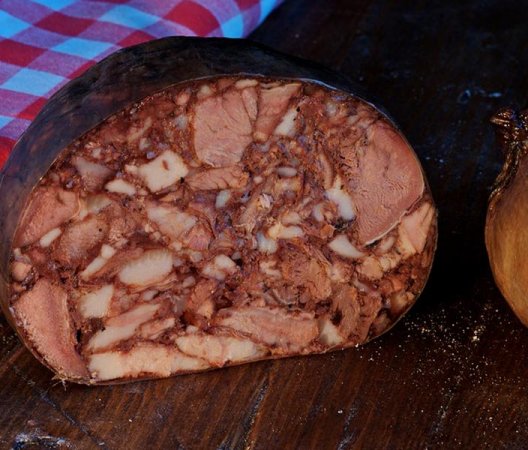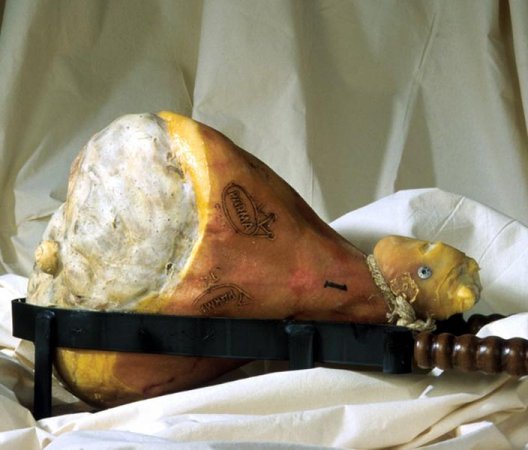MEAT: CARNI
PORK SHOULDER FROM FILATTIERA
Italian Name: Spalla Cotta di Filattiera, e della LunigianaClassifcation: PAT
Production Area: The village of Filattiera, Tuscany
Spalla Cotta is a shoulder of pork that is traditionally produced all over Lunigiana, but more popularly in the municipality of Filattiera. Spalla Cotta must be produced at an altitude between 1,970 and 2,300 feet, Filattiera provides a perfect environment. To make Spalla Cotta, the shoulder and its bone are salted, enriched with spices, and covered with bladder skin, fat skin or pork stomach. Then the meat undergoes an aging process. When the pork is prepared to be eaten, it is freed from the fat wrapping and put in a pot with cold water and salt. Filattiera's Spalla Cotta has a pink color, a spicy fragrance, and a characteristic taste. It is usually cut into slices and served at room temperature. The recommended food pairings are vegetables, or mashed potatoes.

BLOOD SAUSAGE FROM GARFAGNANA
Italian Name: Biroldo della Garfagnana
Classifcation: Slow Food
Production Area: The area of Garfagnana, TuscanyBiroldo is a type of blood sausage and it is one of the most original products there is within the Park. It is a cold cut made with pork meat and blood, flavored with a mixture of spices and fennel seeds, which is very characteristic of Garfagnana. Biroldo of Garfagnana is a loaf-shaped sausage with a diameter of about 7 inches. It has a dark red color, soft texture, and has a signature smell from the spices.
MORTADELLA FROM LUNIGIANA
Italian Name: Mortadella della Lunigiana
Classification: PAT
Production Area: The area of Lunigiana, Tuscany
With this product there are only a few ingredients, which are ground beef, lard, salt and spices. To make this product the meat and lard are cut and cubed and then kept in the refrigerator at 37°F, for at least 12 hours. Next, the meat is minced and mixed with salt, natural herbs and spices. Finally, the seasoned meat is stuffed in natural casings, which has to be soaked for 12 hours, in a brine, and then washed with water and vinegar. It is very important to be careful not to puncture holes in the casing during the procedure.
MONDIOLA FROM GARFAGNANA
Italian Name: Mondiola della Garfagana
Classification: PAT
Production Area: The areas of Garfagnana and Lunigiana, TuscanyMondiola of Garfagnana is also called Mortadella of Lunigiana as the name is dependant on where it is produced. The Mondiola has a U-shape characteristic and is tied up with a laurel leaf in the middle. It is a rather thin pork salami produced in Valle del Serchio and in Garfagnana as well. To produce Mondiola, only pork meat is used. The meat is ground with salt, sugar, aromas, and spices, which vary according to the area and the producer.
HORSE MEAT FROM COMANO
Italian Name: Carne di Cavallo e Puledro di Comano
Classification: PAT
Production Area: The village of Comano, Tuscany
Genuine horse meat of the Comano breed comes from colts that are 6-7 months old and bred in Comano. The animals grow in a wild state with their mothers on the Apennine pastures. In this period, the colt feeds on tender shoots and mountain grass in addition to its mother's milk. The exclusively natural diet, purity of the water in the high mountains and being raised in a wild state gives Comano horsemeat particular, appreciable organoleptic features. The Comano horse has been obtained by crossing selected Franches Montagnes stallions supplied by the Istituto di Incremento Ippico Toscano (Tuscan Horse Breeding Institute) with local mares for more than 30 years.
FILLET FROM LUNIGIANA
Italian Name: Filetto della Lunigiana
Classification: PAT
Production Area: The area of Lunigiana, Tuscany
The meat is a deep pink color with a delicate flavor and a spicy smell. The filet is sprinkled with salt, spices, natural herbs and then refrigerated for 15 days. After this period the filet is rolled, tied, trimmed and put into appropriate casing. It is packaged in either a gut casing or rind. When the filet is dry, it is stored for a minimum of 45 days to mature. The product can be kept for 3 months if bound in a natural casing and kept for 6 months if a rind is used.

PARMA HAM
Italian Name: Prosciutto Crudo di Parma
Classification: PDO
Production Area: The area of Parma, Emilia-Romagna
This ham is an all-natural product made from only four ingredients: pork, salt, air and time. The pigs used in the production must be bred in one of the ten northern and central Italian regions. Salting is a vital part of the curing process and a strict amount of salt is required. The Parma region has a special macroclimate, ideal for the drying of ham and for giving the ham its unparalleled sweetness. Around 7 months after the salting process the ham is smeared with pork fat called "sugna". After a storing period of 1 year, it's time for the quality check. Only hams that meet high standards become Parma ham and are fire-branded with the Parma Crown.
COTECHINO FROM MODENA
Italian Name: Cotechino di Modena
Classification: PGI
Production Area: The province of Modena, Emilia-Romagna
Cotechino is cured pork meat that is minced, ground, and aged according to the local tradition. The ingredients include: pork meat, pork rind, salt, spices, flavorings and herbs. It is served sliced with the traditional side dishes being: mashed potatoes, beans, lentils, and spinach.
MORTADELLA FROM BOLOGNA
Italian Name: Mortadella di Bologna
Classification: PGI
Production Area: The province of Bologna, Emilia-Romagna
Mortadella is a pork sausage that has been made for at least 500 years with origins dating back to Roman times. The sausage starts with finely ground pork, usually from lesser cuts of meat that had not been used for other types of sausage. The meat is mixed with high quality fat, salt, white pepper, peppercorns, coriander, anise, pistachio pieces and wine. Given the ingredients used in the process to get to this point, the sausage has a distinctive aroma. The mixture is stuffed into a pork casing and cooked according to weight. After cooking, the sausage is left to cool which helps give the meat its firmness. The end product must meet specific guidelines of the IGP, to be called Mortadella di Bologna. The sausage is slightly spicy, however the heat is offset by the lardons. Mortadella is a very versatile sausage that can be served with walnuts, cheeses, and tart berries. This also can be used as a base for a delicious creamy spread or even as an ingredient for antipasti.
SALAMI FROM CASTELNUOVO MONTI
Italian Name: Salame di Castelnuovo Monti
Classification: PAT
Production Area: The village of Castelnovo ne' Monti, Emilia-Romagna
The Salami is created using the best pigs bred in the province of Reggio Emilia. The meat is minced and mixed with salt, pepper, spices and garlic. The mixture is stuffed in a natural casing and closed with a twine. The aging lasts from a minimum of 70 days to a maximum of 180 days. The color of the salami meat is red and the fat is white. The salami has a strong aroma which compliments the richness and unique characteristics in flavor of the meat.
CANUSIANA BACON
Italian Name: Pancetta Canusiana
Classification: PAT
Production Area: The region of Emilia-Romagna
Canusiana bacon is a salami of the Emilia-Romagna side of the Apennine Mountain. This bacon was introduced more than thirteen centuries ago by the Lombards coming from Germany. It has a spicy taste and is produced with the fresh pig belly that has been butchered no more than two days before. Secret quantities of salt, sugar, spices, and natural aromas are added according to tradition. The bacon is rolled or split, according to the final presentation on the market. It is typically eaten as an appetizer or second dish. It is also used to season local dishes of Emilia-Romagna.
HUNTER'S STYLE SALAMI
Italian Name: Salamini Italiani alla Cacciatora
Classification: PDO
Production Area: The area of Garfagnana, Tuscany
The Salami is produced with selected light pork meats and cured in a natural casing. The production and storing process follows the local traditions from Garfagnana.
TUSCAN PROSCIUTTO
Italian Name: Prosciutto Toscano
Classification: PDO
Production Area: The region of Tuscany
The traditional production process of Prosciutto starts with the selection and trimming of the thighs. Then meat is then salted with sea salt. The salting lasts about four weeks and is followed by the pre-aging phase. In this phase the ham undergoes a gradual dehydration, which is accompanied by a slow maturation of the meat. After six months, all hams move to the "Sugnatura" phase. This phase is when the meat and exposed bone is covered with pig fat. From this moment, the maturation phase begins where the hams mature slowly in a controlled environment, under optimal temperature and humidity. The hams ripen for at least ten months before the olfactory characteristics are evaluated. Following this verification or dismissal, the hams that are considered suitable are branded with the Prosciutto Toscano PDO mark, which guarantees quality.









